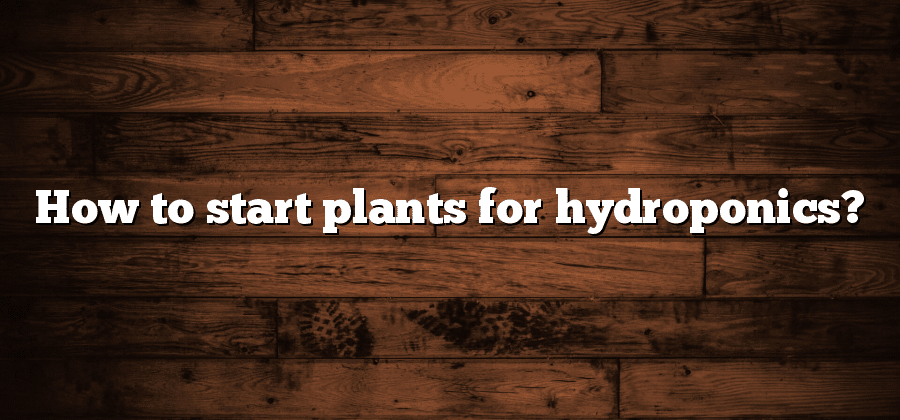Understanding Hydroponic Plant Growth
Hydroponic plant growth is a fascinating and innovative method of cultivating plants without the need for soil. Instead, plants are grown in nutrient-rich water solutions, providing them with all the essential nutrients they need for healthy development. This technique offers several advantages, including faster growth rates, higher yields, and the ability to grow plants in areas with limited access to arable land.
One of the key factors in hydroponic plant growth is the precise control and optimization of environmental conditions. By closely monitoring factors such as temperature, humidity, light, and nutrient levels, growers can create an ideal environment for their plants. This level of control enables faster growth and helps to minimize the risk of pests and diseases. Additionally, hydroponic systems allow for the recirculation and conservation of water, making them a more sustainable and eco-friendly option compared to traditional soil-based farming methods.
Selecting the Right Hydroponic System
When it comes to selecting the right hydroponic system for your needs, there are several factors to consider. Firstly, think about the space you have available. If you have a limited amount of space, a vertical hydroponic system might be the best option as it maximizes the use of vertical space. On the other hand, if you have a larger area to work with, a horizontal hydroponic system could be a better fit.
Secondly, consider your level of experience with hydroponics. If you’re a beginner, a simple, ready-to-use system like a nutrient film technique (NFT) or deep water culture (DWC) system might be the easiest to start with. These systems are relatively low-maintenance and don’t require complex setup procedures.
Lastly, think about the specific plants you want to grow. Different hydroponic systems have varying capabilities when it comes to accommodating different types of plants. For example, a drip irrigation system might be suitable for larger, fruiting plants like tomatoes, while an aeroponic system might be better for smaller leafy greens like lettuce.
Taking these factors into account will help you make an informed decision when selecting the right hydroponic system for your needs. Remember to always thoroughly research and consider your options before investing in any particular system.
Choosing the Ideal Plant Varieties
When it comes to hydroponic gardening, choosing the ideal plant varieties is crucial for successful growth and maximum yield. The selection process involves considering various factors such as growth habits, nutrient requirements, and environmental conditions. It is essential to choose plants that are well-suited for hydroponic systems and can thrive in nutrient-rich water solutions.
One key consideration when selecting plant varieties for hydroponics is their growth habit. Some plants, such as lettuce and other leafy greens, have a compact growth habit and require less space to flourish. On the other hand, plants like tomatoes and cucumbers tend to vine and require more vertical space. Therefore, it is important to choose plant varieties that can be accommodated within the specific hydroponic system you are using. Matching the plants’ growth habit with the available space will ensure space efficiency and avoid overcrowding, which can lead to poor plant development and reduced yield.
Preparing the Growing Medium
Preparing the growing medium is a crucial step in hydroponic plant growth. The medium serves as a substitute for soil, providing the necessary support and nutrients for the plants to thrive. When selecting a growing medium for your hydroponic system, it is essential to consider its water-holding capacity, ability to provide adequate oxygen to the roots, and pH stability.
One common choice for a hydroponic growing medium is coconut coir. This organic material derived from coconut husks has excellent water retention properties while also allowing for sufficient drainage. It is pH neutral, reducing the need for frequent adjustments. Another option is perlite, which is a lightweight, porous material that provides good aeration for the roots. However, it has limited water-holding capacity and may require more frequent irrigation. Vermiculite can also be used as a growing medium, as it retains water well and provides good aeration. However, it is important to note that vermiculite has a higher alkaline pH, so adjustments may be needed. As each growing medium has its advantages and considerations, it is important to select one that suits the specific requirements of the plants you plan to grow.
Germinating Seeds for Hydroponics
When it comes to germinating seeds for hydroponics, there are a few key factors to consider. First and foremost, selecting high-quality seeds is essential. Look for seeds that are fresh, disease-free, and from reputable sources. Additionally, different plant varieties have different germination requirements, so it is important to choose the right ones for your hydroponic system.
Once you have selected your seeds, the next step is to provide them with the optimal conditions for germination. This typically involves placing the seeds in a suitable growing medium, such as rockwool cubes or peat pellets, that is moist but not overly saturated. It is important to maintain a consistent temperature and humidity level during the germination process, as fluctuations can negatively impact seed viability. By following these steps, you can ensure successful germination and get your hydroponic garden off to a healthy start.






